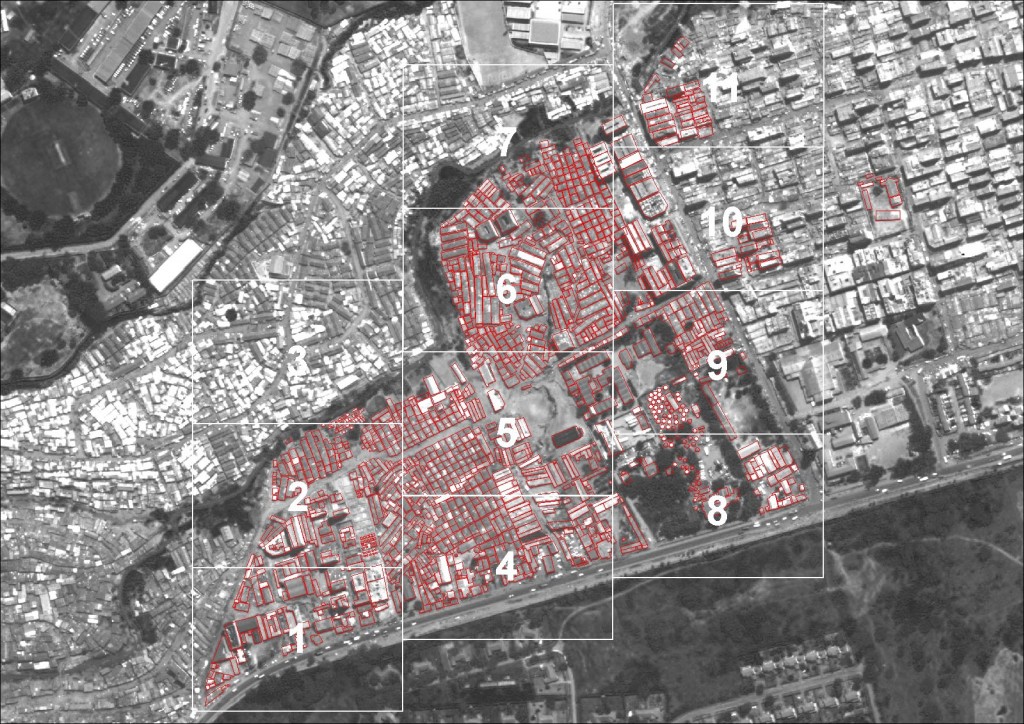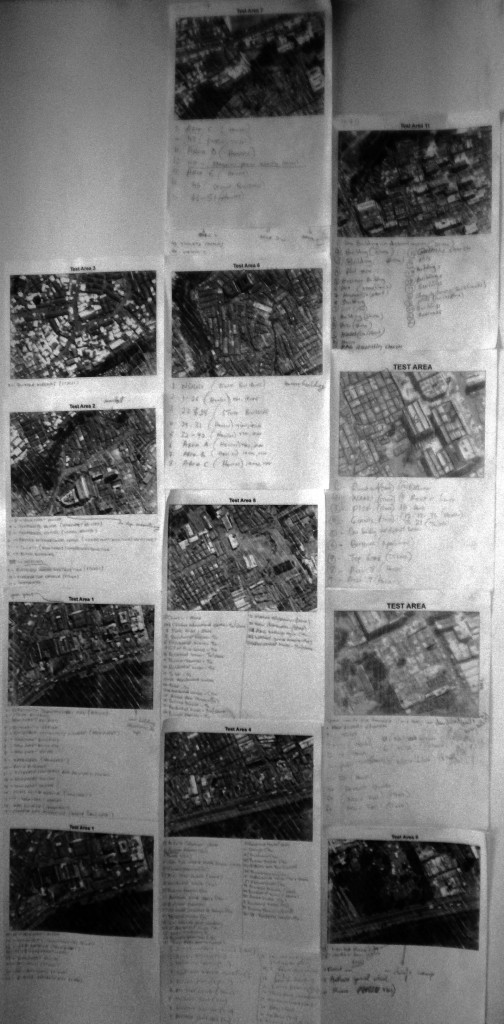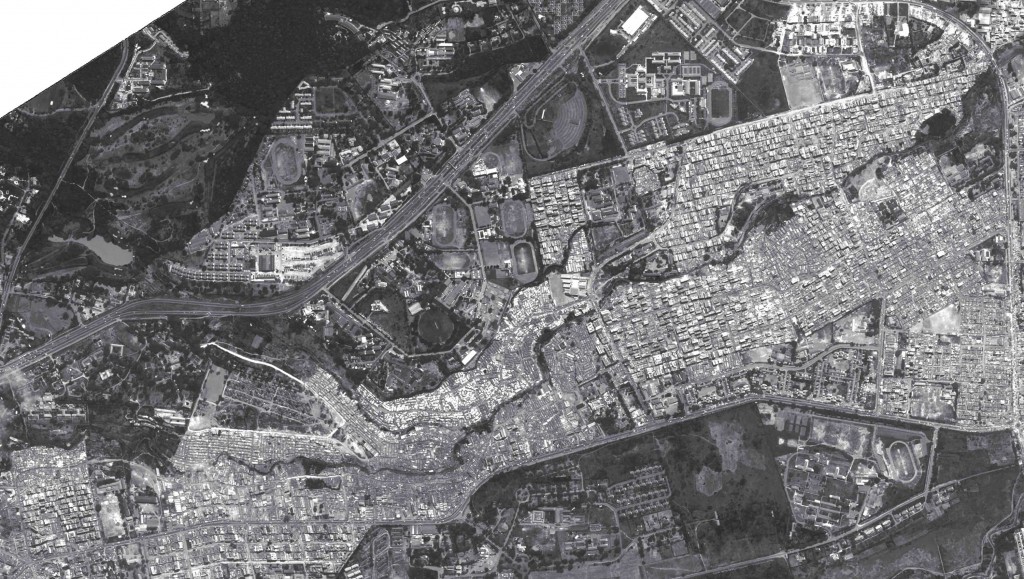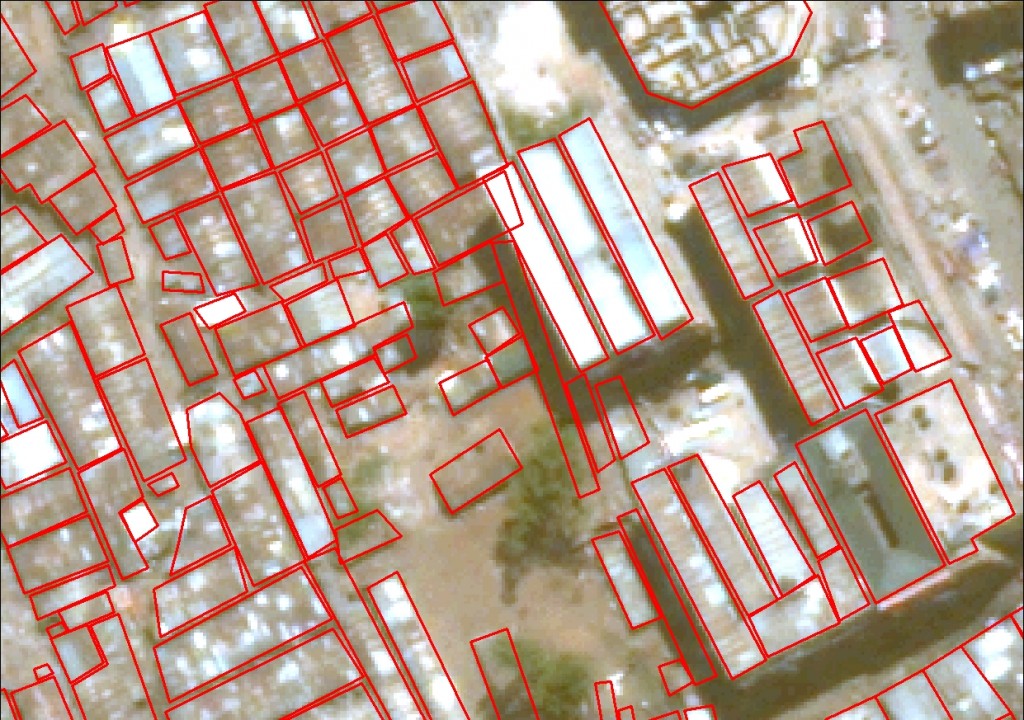by: primoz February 17th, 2011 comments:
We have completed the ground truthing of a test area of Mathare 10, Mashimoni, Mabatini and Thayu. The whole exercise took us two days. It took us one day to prepare – determine how to go about it, go out in the field to see how it works, what needs improving and to create proper forms which make sense. Then we divided the area into 11 smaller areas of focus for which we created detailed forms for data collection. By detailed forms I mean an A4 paper with a picture on top. Remember! It’s the execution that counts, he he…

Test area divided into smaller areas
We held a brief meeting on Wednesday, 16.2.2011, with all the Mathare mappers where we talked about the theories behind satellite imagery, building extraction, the importance of collecting such information and explained how the exercise will run in detail.
It took 5 groups 3 hours on Thursday, 17.2.2011, to check all the buildings in the test area, fix incorrect shapes of buildings, write down the types of buildings, and classify them. In other words, it took them 3 hours to ground truth 0.21 square kilometers which represents 7% of the whole Mathare area.

Some of the Data collected
Through the exercise, we’ve encountered some problems which we need to address to AAAS for further clarification and advice. For example, how do we ground truth a big stone building which has tin houses on top of it? Is it one building or many (picture below in a circle)?

Tin buildings on top of a brick building
The next step is to digitize the data collected, send it back to the AAAS, and then wait.
by: primoz February 16th, 2011 comments:
The American Association for Advancement of Science (AAAS) donated us a WorldView-2 image (read more) with 6% cloud cover, taken on 30th of June 2010. It covers the areas of Mathare Valley, Korogocho, Kariobangi, Baba Dogo, as well as part of Kasarani, Dandora, and some surrounding areas. Altogether, the imagery is of a broader eastern part of Nairobi, containing the areas with the highest concentration of people in the city.

Satellite image of Mathare
The image is of course useful in numerous ways, but the first thing we want to use the image for is to create a building extract for the whole area of Mathare! The AAAS showed a great interest in helping us with this issue and is indeed helping us now. The deal was that we set out a test region to begin with so one of their analysts could analyze that area. We would then take a look at it and go to the field to ground check their mapping. If that worked out satisfactorily, they would expand the extraction further to do the whole area.
As said, we first set out the test region for them to analyze. Our focus was on Mathare 10, Thayu, Mabatini, and Mashimoni. We picked the area because it is situated very centrally in Mathare, has different variety of buildings (tin and brick) and is also an interest area of our partners, Plan Kenya and CCS. A day after the area was set we got the first results – the first automated building extract of the area.

Building extraction on a test area
A quick look already revealed some of the faultinesses of the automated process like overlaying shapes, crooked shapes of objects, shattered uniform objects and merged diverse objects, digitized/mapped non-existing objects, etc.

Some of the faultinesses of the automated process
Our next “jobâ€, which is currently under way, is ground truth-ing the results. This basically means checking every object in the field and comparing it to the created extracts, than confirming or rejecting certain objects, classifying them, repairing the shape files, digitizing collected (repaired) information and sending it back so they can reset their algorithms.

Ground Truthing
The biggest challenge is how do we do that practically with limited equipment and resources? We knew from the start that we’ll get the best results if the people who come from the area are the ones ground truth-ing their own area. This is also important because this kind of work basically takes you into the compounds and backyards of houses and you obviously don’t want strangers walking on other people’s backyards.
For the purpose of data collection I created forms, printed them out, bought some pencils, sharpeners and erasers and called Francis and Jackson from Mashimoni to take me around their neighborhoods and give me the feedback – they are two of the mappers who will be the ones leading the project on the ground later, which is why their opinion is crucial.

Francis and Jackson in action
During the exercise we focused on specifics like:
- We numbered each house in the test area, classified them and added different types of buildings (tin, brick, etc.)
- We repaired shapes of the buildings extracted
- We deleted redundant shape files
- We wrote down names of all known landmarks
The guys also gave me feedback regarding the forms:
- Prepare a bigger map of the whole test area and outline the smaller area on it for better recognition of the area
- Add names of the roads to the forms for better recognition of the area
- Make darker outlines of extracted buildings on the forms
- Add names of landmarks for better recognition of the area
After the ground truth-ing of the area the AAAS will (hopefully) expand the extraction to the whole of Mathare. And then the fun really begins!
by: primoz February 14th, 2011 comments:
We’ve completed the base map of Mathare. It took us 17 days during which 15 mappers (on average each day) would map and edit for an average of 5 hours per day. That accumulates up to 1250 man hours. Of course the exact figure of man hours is much lower mainly due to a limited number of computers and equipment which resulted in many of the mappers just strolling along or observing the creation of the map from afar. We have mechanisms prepared for this type of instance, as we want everybody interested to learn and contribute. One of these mechanisms, which we implemented in the last two weeks of mapping, is rotating venues.
If I throw some statistics at you, the base map has – or, if I put it differently, mappers have collected, edited and digitized:
- 750 points
- 41.3 km of roads and paths
- 24 Mathare villages digitized, altogether an area of 3006444 m2 3.0064444 km2
- 138 buildings digitized, altogether an area of 58322 m2 or 0.058322 km2
- Other areas digitized (walled areas, fields, football and recreational pitches, natural areas, etc.)comprise 360602 m2 0.360602018 km2
Below is the base map where the first map (Map 1) presents only the points collected and the second map (Map 2) presents the types of resources collected (represented by points), such as hospitals, toilets, water points, schools, religious institutions, etc.

Map 1

Map 2








